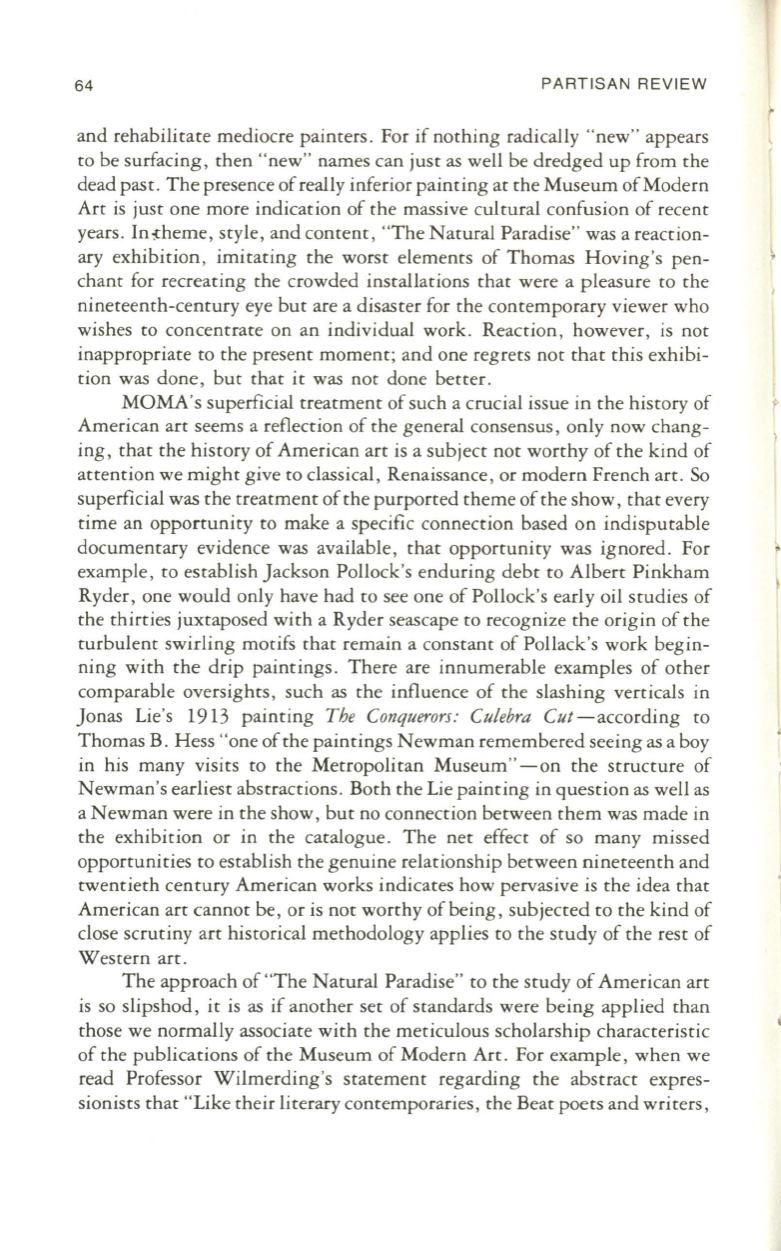
64
PARTISAN REVIEW
and rehabilitate mediocre painters. For if nothing radically "new" appears
to be surfacing, then "new" names can just as well be dredged up from the
dead past. The presence of really inferior painting at the Museum ofModern
Art is just one more indication of the massive cultural confusion of recent
years . In.,rheme, style, and content, "The Natural Paradise" was a reaction–
ary exhibition, imitating the worst elements of Thomas Hoving 's pen–
chant for recreating the crowded installations that were a pleasure to the
nineteenth-century eye but are a disaster for the contemporary viewer who
wishes
to
concentrate on an individual work. Reaction, however, is not
inappropriate to the present moment; and one regrets not that this exhibi–
tion was done, but that it was not done better.
MOMA's superficial treatment of such a crucial issue in the history of
American art seems a reflection of the general consensus, only now chang–
ing, that the history of American art is a subject not worthy of the kind of
attention we might give to classical, Renaissance, or modern French art. So
superficial was the treatment of the purported theme of the show, that every
time an opportunity
to
make a specific connection based on indisputable
documentary evidence was available, that opportunity was ignored . For
example, to establish Jackson Pollock's enduring debt
to
Albert Pinkham
Ryder, one would only have had to see one of Pollock's early oil studies of
the thirties juxtaposed with a Ryder seascape
to
recognize the origin of the
turbulent swirling motifs that remain a constant of Pollack's work begin–
ning with the drip paintings . There are innumerable examples of other
comparable oversights, such as the influence of the slashing verticals in
Jonas Lie's 1913 painting
The Conquerors: Culebra
Cut-according to
Thomas B. Hess "one of the paintings Newman remembered seeing as a boy
in his many visits to the Metropolitan Museum" -on the structure of
Newman's earliest abstractions . Both the Lie painting in question as well as
aNewman were in the show, but no connection between them was made in
the exhibition or in the catalogue . The net effect of so many missed
opportunities to establish the genuine relationship between nineteenth and
twentieth century American works indicates how pervasive is the idea that
American art cannot be, or is not worthy of being, subjected to the kind of
close scrutiny art historical methodology applies
to
the study of the rest of
Western art.
The approach of "The Natural Paradise" to the study of American art
is so slipshod, it is as if another set of standards were being applied than
those we normally associate with the meticulous scholarship characteristic
of the publications of the Museum of Modern Art . For example, when we
read Professor Wilmerding's statement regarding the abstract expres–
sionists that "Like their literary contemporaries, the Beat poets and writers,


